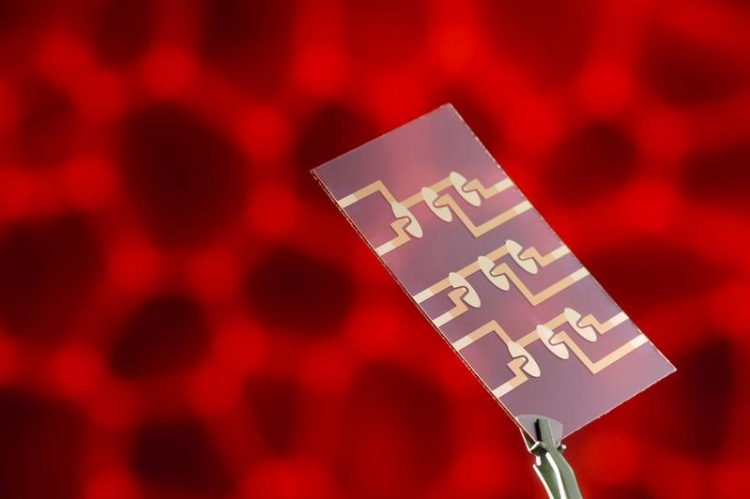New approach in the fight against viruses

Multi-Electrode Layout for Parallel Analysis of Multiple Cell Samples in Microfluic-Chips. Fraunhofer EMFT, Bernd Müller
Most people see vaccinations as a benefit of modern medicine, as they protect against dangerous viral diseases. However, before a vaccine can enter the doctor‘s surgery, it is first tested for its effectiveness in order to ensure reliable protection.
These tests are typically carried out in the laboratory on cultured cells. First the blood serum of a previously vaccinated person is injected into the cell culture, then the test cells are exposed to a virus infection. If the vaccination was successful, the serum contains sufficient neutralizing antibodies against the viruses and the virus contact has no consequences.
This serves as a proof of the efficacy of a vaccine. If the vaccination was not efficient enough, the antibody titres in the serum are not sufficient to completely intercept the viral load. The cells used for the test are then defenceless against the viruses and are infected.
To date, a possible infection of the test cells is analyzed using labour-intensive and expensive staining methods which has an increasingly limiting effect in view of the enormous number of tests required for vaccine development.
Scientists of the Fraunhofer Institute for Biomedical Engineering IBMT in Sulzbach/Saar and the Fraunhofer Facility for Microsystems and Solid State Technologies EMFT on the campus of the University of Regensburg are currently working together with the companies nanoAnalytics GmbH (Münster) and innoMe GmbH (Espelkamp) on a novel solution for the measurement of antiviral neutralizing antibodies.
For this purpose, the test cells are placed on multi-electrode arrays, which allow their infection status to be recorded completely automatically with the aid of electrochemical measuring methods. This replaces the costly staining reactions of conventional tests, which saves time and money.
Another advantage of the new method is that the cells are continuously monitored over a longer period of time. With the previously used staining methods, they are only analyzed at a specific point in time. This provides the researchers with additional information on the time course of the cell reaction that was previously not available.
The consortium has set itself the goal of researching a complete system, including the measuring device, the associated analysis software and the electrode arrays required for cell observation, and implementing it in laboratory set-ups that will pave the way for a later market launch.
The „ViroSens“ project is funded by the Federal Ministry of Education and Research (BMBF) under the KMUinnovativ funding guideline with a total amount of around €2 Million.
Prof. Hagen von Briesen l Fraunhofer IBMT l Phone +49 6897 9071-286 Hagen.Briesen@ibmt.fraunhofer.de
Prof. Joachim Wegener l Fraunhofer EMFT l Phone +49 9471 943 45 46 Joachim.Wegener@emft.fraunhofer.de
https://www.ibmt.fraunhofer.de/en/ibmt-press-releases-2019/press-ViroSens-2019-0…
Media Contact
All latest news from the category: Life Sciences and Chemistry
Articles and reports from the Life Sciences and chemistry area deal with applied and basic research into modern biology, chemistry and human medicine.
Valuable information can be found on a range of life sciences fields including bacteriology, biochemistry, bionics, bioinformatics, biophysics, biotechnology, genetics, geobotany, human biology, marine biology, microbiology, molecular biology, cellular biology, zoology, bioinorganic chemistry, microchemistry and environmental chemistry.
Newest articles

First-of-its-kind study uses remote sensing to monitor plastic debris in rivers and lakes
Remote sensing creates a cost-effective solution to monitoring plastic pollution. A first-of-its-kind study from researchers at the University of Minnesota Twin Cities shows how remote sensing can help monitor and…

Laser-based artificial neuron mimics nerve cell functions at lightning speed
With a processing speed a billion times faster than nature, chip-based laser neuron could help advance AI tasks such as pattern recognition and sequence prediction. Researchers have developed a laser-based…

Optimising the processing of plastic waste
Just one look in the yellow bin reveals a colourful jumble of different types of plastic. However, the purer and more uniform plastic waste is, the easier it is to…



